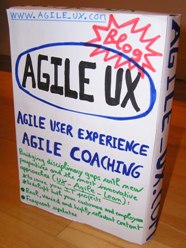A Speed Boat or nothing…
TweeterPosted by jc-Qualitystreet on 2011/10/17
Speed Boat is one of the « Innovation games« , one of those games that, like Product Vision Box , Remember the future or Buy a feature, is very useful during our Agile and UX workshops.
Speedboat is an interactive, collective and funny way to identify constraints, obstacles, problems with our product or our project, then to prioritize actions in order to remove them!
Speed boat, a boat with many facets…
The advantage of the Speed Boat metaphor is that the game can be very useful in a lot of contexts. Indeed, our boat is appropriate to represent our development project (which does not advance for some reason…), our product, subject to criticisms and comments of its users or the team in charge to bring agility to the organization.

Result of our Speedboat WorkShop ...The goal is the Agile Enterprise
The rules of the game
- Draw a speed boat on a whiteboard or poster
- The boat is our system, our product, our project or our team, so name it (Here, the boat is our Agile transition team)
- Of course, the objective of the Speed boat (our product…) is to go fast (for best performance). So I first ask the participants to describe us precisely what characterizes the optimal performance, the desirable conditions (yellow notes attached to the port or on the island that the boat needs to reach)
- The boat position represents today and the distance between the boat and the island can be seen as an indicator (not in our case)
- The anchors represent the obstacles slowing the movement of our boat: impediments or things that our customers or users do not like about our product and affect its optimal functioning. The more they are low under the water, the more they are strong (well, up to you to follow this rule!)
- The green arrows represent positive elements that push our boat
Facilitation
Several variations exist. Here is mine
- Steps 1 & 2 After the opening and introduction of the game, I usually ask participants to work individually or in pairs (depending on group size) on the goal (desirable conditions) and the positive factors then to present their work to others.
- Step 3: Then, individually or in small groups it is time to characterize the anchors (obstacles, constraints, things we don’t like)
- Step 4: The work done, I ask the participants to post their anchors on the wall.
- Step 5: Collective consolidation and anchors prioritization
- Step 6: I usually close the game with an action plan to set up to remove the major anchors!
In short, we generally have a good time playing that game: enjoyable, useful but also very effective!
Tweeter

